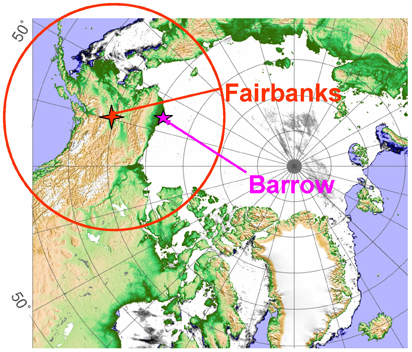WP-3D Instrumentation

Map showing the area of operation for ARCPAC. The WP-3D aircraft will be based in Fairbanks, Alaska. The typical out-and-return range of the aircraft is shown by the red circle.
Based on scientific questions Q1-Q6 and the measurement requirements R1-R7 that logically follow, NOAA will operate a WP-3D aircraft in the Alaskan Arctic in spring of 2008 as part of the International Polar Year (IPY). NOAA's Earth System Research Laboratory (ESRL) and extramural colleagues have developed a powerful set of precise and accurate gas- and particle-phase instruments for airborne investigations of air quality and climate-relevant chemical and microphysical processes ranging in scale from tens of meters to intercontinental distances. In particular, NOAA has developed new, sensitive instruments for determining aerosol optical properties, including a cavity ringdown method for directly measuring aerosol extinction at multiple wavelengths and its variation with relative humidity.
ESRL scientists have also substantially modified, evaluated, tested, and operated on aircraft a recently developed commercial instrument that measures the number and mass of individual soot particles and that can determine the amount of condensed coating on them. NOAA has also developed an unique instrument for measuring the composition of single aerosol particles and the residue from evaporated cloud particles, and has optimized a commercial aerosol mass spectrometer for airborne non-refractory aerosol composition measurements. In addition, the NOAA Aircraft Operations Center has recently purchased a set of state-of-the-art cloud probes for measuring the number, size, and shape of cloud and precipitation particles. With the addition of well-tested gas-phase and radiometric measurements, this payload is ideal for addressing the climate-relevant scientific questions outlined below.
The diverse objectives of the ARCPAC project cannot be met without the experimental and scientific talents of non-NOAAcolleagues. In particular, measurements of IN, CCN, bulk aerosol composition, solar spectral irradiance and infrared irradiance, VOCs, and transport and chemical-transport modeling require equipment and expertise from researchers from universities, other governmental laboratories, and international research organizations.
| Priority instruments for the WP-3D aircraft during ARCPAC | |
|---|---|
| Parameter | Method |
| Direct effect instruments | |
| Size-resolved non-refractory aerosol composition | Compact time-of-flight aerosol mass spectrometer |
| Single particle black carbon | Single particle soot photometer (SP2) |
| Single particle composition | Laser mass spectroscopy |
| Bulk particle composition | Particle-in-liquid sampler, IC |
| Aerosol size distribution | Multiple CPCs, OPCs |
| Aerosol extinction (532, 1064 nm), f(RH) | Cavity ringdown |
| Filter-based aerosol absorption (467, 530, 660 nm) | Particle soot absorption photometer |
| Indirect effect instruments | |
| Cloud condensation nuclei concentration | CCN counter |
| Liquid water content/Total water content | Hot wire probes |
| Cloud particle size distribution (0.5-50 μm) | Forward/back scattering-cloud and aerosol spectrometer |
| Cloud particle size distribution | Forward scattering-cloud droplet probe |
| Cloud particle size distribution (25-1550 μm), imaging/phase | Photodiode imaging-cloud imaging probe |
| Soot | SP2 |
| Actinic fluxes (near 280-690 nm, ↑ and ↓) | Spectral actinic flux radiometer |
| Spectral irradiance (300-1700 nm, ↑ and ↓) | Solar spectral flux radiometer |
| IR irradiance (4.5-42 μm, ↑ and ↓) | Pyrgeometers |
| Tracer and halogen chemistry instruments | |
| Ozone (O3) | NO chemiluminescence |
NO, NO2| O3 chemiluminescence | |
| Carbon dioxide (CO2) | Nondispersive IR |
| Carbon monoxide (CO) | UV fluorescence |
| VOCs | Whole-air sampler |
| SO2 | UV fluorescence and chemical ionization mass spectrometry (CIMS) |
| HNO3 | CIMS |
| Peroxyacyl nitric anhydrides (PANs) | CIMS |
| Halogens (ClNO2, Br2, Cl2, BrCl, BrO) | CIMS |



